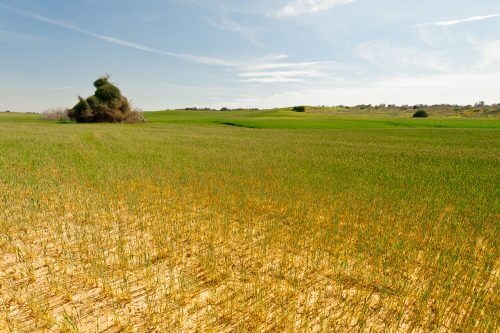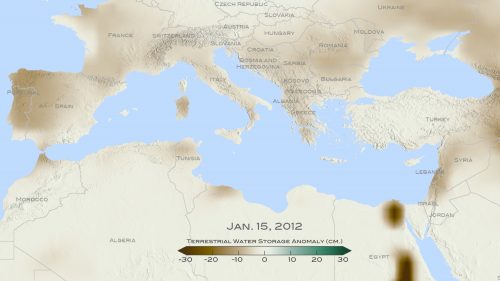The scientists recreated the history of drought in the eastern Mediterranean by studying tree rings as part of an effort to understand the region's climate and groundwater. Thin rings indicate dry years while thick rings are evidence of years when water was plentiful.

A new study reveals that the last drought that began in 1998 in the Levant region in the eastern Mediterranean, in an area that includes Cyprus, Israel, Jordan, Lebanon, the Palestinian Authority, Syria and Turkey, is the most severe drought in the last nine years.
The scientists recreated the history of drought in the eastern Mediterranean by studying tree rings as part of an effort to understand the region's climate and groundwater. Thin rings indicate dry years while thick rings are evidence of years when water was plentiful.
In addition to identifying the driest years, members of the team of scientists discovered patterns in the geographic distribution of droughts that provide a "fingerprint" for identifying the underlying causes of dryness. Together, these data show the range of natural variability of drought occurrence in the Mediterranean region, which will allow scientists to identify whether droughts have been exacerbated by global warming caused by human activity. The research is part of NASA's ongoing work to improve computer models for simulating the current and future climate.
"The magnitude and significance of human-made climate change requires us to really understand the full range of natural climate variability," said Ben Cook, the paper's lead author and a climate scientist at NASA's Goddard Institute for Space Research and Columbia University's Earth Observatory in New York.
"We have examined the recent events and we are beginning to see anomalies because they are outside the range of natural variability. Therefore, we can say with a certain degree of confidence that there was a contribution of climate warming to this event or series of events." said.

Cook and his colleagues used a tree-ring record they called the Old World Form Atlas to better understand the frequency of droughts and how they occurred in severe forms in the Mediterranean in the past. Live and dead tree rings were sampled all over the region: North Africa, Greece, Lebanon, Jordan, Syria and Turkey. Combined with existing tree-ring records from Spain, southern France and Italy, these data were used to reconstruct geographic drought patterns over the past thousand years. The results have been accepted for publication in the journal ATMOSPHERIC RESEARCH of the American Geophysical Union AGU
Between the years 1100 and 2012, the group found a tree-ring in the forms in the record that it discovered matched the droughts recorded in the historical documents written in real time. According to Cook, the range of extremely wet or dry periods was quite wide, but the last drought in the Levant region, from 1998 to 2012, was dry for more than 50% of the period compared to the driest in the last 500 years, and 10-20% dry More than the worst drought in the last 900 years.
Because the study covered a large area that allowed him to not only see changes in time but also geographical changes across the region.
In other words, they asked if when there is drought in the eastern Mediterranean, is there also a drought in the west? The answer is yes, in most cases, said Kevin Anchokaitis, one of the study's authors and a climate scientist at the University of Arizona in Tucson. "This is true both in modern society and in ancient cultures. This means that if one area suffered from the effects of drought, these conditions existed throughout the Mediterranean basin. Since there is nowhere to run, this has the potential to disrupt food systems on a large scale and create conflicts over control of water sources."
In addition, the team of scientists found that the northern part of the Mediterranean Sea: Greece, Italy, and the coasts of France and Spain tended to be dry when the eastern part of North Africa was wet, and vice versa. These east-west and north-south relationships helped the group understand the atmospheric and marine conditions that lead to dry and wet periods in the first place.
"The Mediterranean Sea is one of the areas where all the models unanimously predict that it will dry up in the future due to human-made climate change," said Yohanan Kushnir, a climate scientist at the Mont Doherty Earth Observatory, who was not involved in the study. "This study shows that the weather behavior during the recent drought is different from what we see in past records," he said. "In other words, in the Levant region we are already feeling the severity of the impact of the warming of the earth caused by human activity."
The research could help us refine computer models predicting the risks of drought in the coming century, Kushnir said.

4 תגובות
Spirol
Trees do not get water from groundwater.
Groundwater is hundreds of meters underground.
Could it be that trees have less water simply because humans consume more water, regardless of global warming.
As man and industry consume more water and dry up groundwater more, it makes sense that trees, among other things, will be able to receive less water, we don't have to involve global warming in the process.
In the context of the earth being overpopulated.
In my opinion, the Americans have reached maturity in the ability to build technology for a trip to Mars. Technologies that until today were considered science fiction. Therefore, and due to the (at most) partial recovery from the 2008 recession, they are renewing the missile program for launching outside of Israel. They will perhaps build a spacecraft in space and will not share the technology with their ally beyond sharing the YF35 fighter jet. They sell it to the Allies at a very high price, they don't sell the YF22 over 13 years to the Allies - the technology came late. It is not applicable to build an entire spacecraft on Earth. Easier to build modules and assemble in space. Then they will send her to Mars. Mars will be theirs alone and will give them an advantage over China for dozens of years.
They may have realized that just as Europe needed new worlds, the Earth also needed new worlds. The main driving problem may have been solved - they won't tell us, the problem of nutrition in space and on another planet, water, oxygen. The problem of the absence of gravity. The spaceship won't look that different from the movie Saving Mark Watney. The technology that is being developed for a trip to Mars - almost all of it can be commercialized on Earth. Agricultural growth in a hostile environment, sustainable propulsion for over a decade, reaching dizzying speeds, artificial intelligence, processed compressed food and much more. The colony on Mars will also be commercialized under the right conditions.